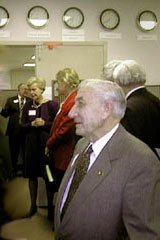
Tracing and Information Center
 |
Tracing and Information Center |
|
|
|
Welcome to the Holocaust Tracing Center
More than 50 years have passed since World War II ended, but the fate of many victims of the war and the Holocaust is still unknown. The Nazi regime tore families apart as it sent millions of men, women and children into forced labor or shipped them to concentration camps where they disappeared and were never seen again. Today, the fate of family members and friends lost during the violence and turmoil of WWII is a lingering sorrow for thousands of people. For the families that survived, the end of WWII marked the beginning of a lifetime of searching. The Holocaust and War Victims Tracing and Information Center, located in Baltimore, Maryland, is trying to discover the fate of people lost in Europe and the former Soviet Union during the WWII era. The Holocaust was an extraordinary time...and was the tragedy of all ages. It was the ultimate humanitarian disaster. The center, which is housed in the headquarters of the Central Maryland Red Cross, is an American Red Cross service provided through its nationwide network of more than 1,200 local chapters. The center works to trace and, if possible, reunite family members separated by the war. It is estimated that more than 280,000 people living in the United States have survived the Second World War/Holocaust or are the children and grandchildren of survivors. Because of the complexity of the search and the enormous volume of requests received, efforts may take a year or more. Linda Klein, the center's director said, "People need closure and with the aging survivor population, the time we have left has become critical. It is very important that people know they can turn to the American Red Cross for information." Since the center opened in 1990, more than 900 people have been found alive, leading to joyous reunions with loved ones after half a century of separation. One such reunion was that of Flora Singer and her cousin Henry who became separated during the Holocaust, and with the help of the Los Angeles Chapter found each other in 1998 after 52 years of searching. And from the Ukraine, Meyer Schwartz and his sister Maria, separated as children, ended their lifelong search after 52 years with the help of the ARC of Greater New York. Each year, the center searches for 3,000 to 4,000 people. For many survivors, the search brings the solace of learning-after years of uncertainty-what happened to loved ones. During the past ten years, there have been nearly seven thousand confirmations of deaths, deportations and transfers to internment camps. In the words of one survivor, "I would like to thank you for the information you have given me about my cousin (who) died in Auschwitz…even though it is so sad, it is better to know." American Red Cross chapters are connected to a global network of Red Cross and Red Crescent National Societies as well as to the Magen David Adom in Israel, the International Tracing Service (ITS) in Arolsen, Germany, and hundreds of state archives, museums and organizations throughout the world. Administered by the International Committee of the Red Cross, the ITS houses more than 46 million records, the largest repository of Nazi documentation in the world. Its sole mission is to make documents relating to people displaced by WWII accessible. For questions about the American Red Cross Holocaust and War Victims Tracing and Information Center contact Linda Klein, Director, at (410) 764-5311; e-mail . |
 HWVTIC volunteer Morris Rosen is always willing to talk about his experience during the Holocaust
|

|

|

|

|

|

|

|

|

|

|

|